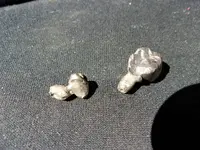bigfoot1
Silver Member
- Joined
- Nov 1, 2011
- Messages
- 3,765
- Reaction score
- 3,399
- Golden Thread
- 1
- Location
- so.cal.mtns.
- 🥇 Banner finds
- 1
- 🏆 Honorable Mentions:
- 1
- Detector(s) used
- garrett,minelab,fisher,,,atp current weapon of choice
- Primary Interest:
- Metal Detecting
Was hunting an area that gets some snow play today.Hit a coin spill just above a big ol pine.I figured someone either hit that tree or crashed to avoid it.then I found these two platinum teeth and the verdict was in....bam...he hit the tree !!almost 11 grams and easily passes platinum acid test on the stone.feel bad for the guy...but dang...platinum.



Upvote
19





